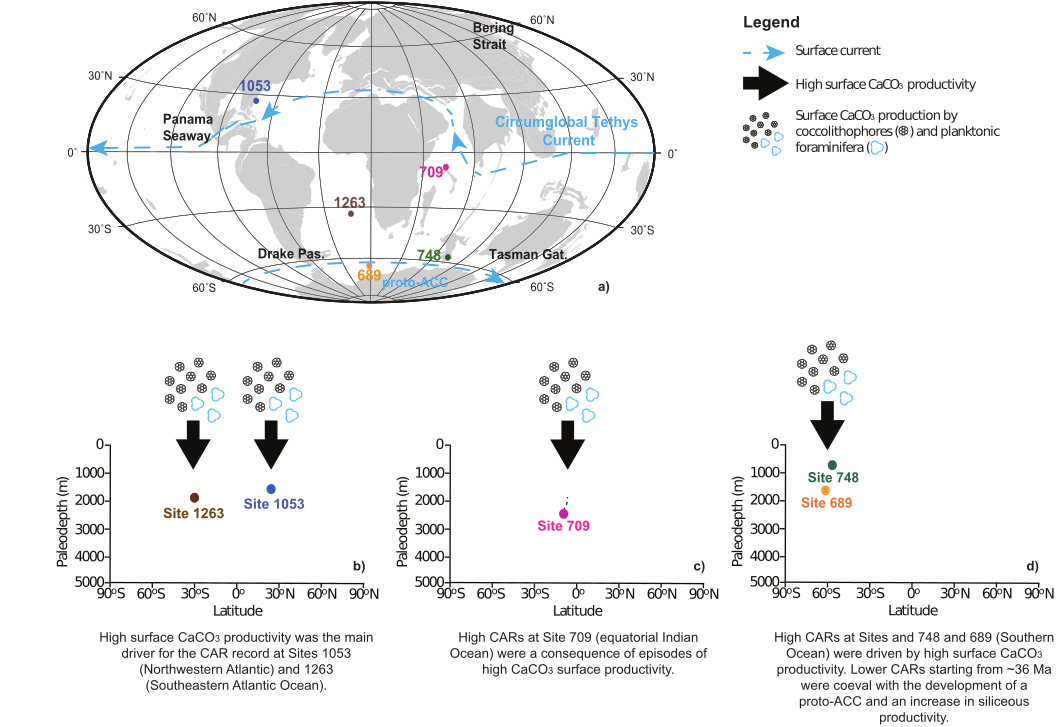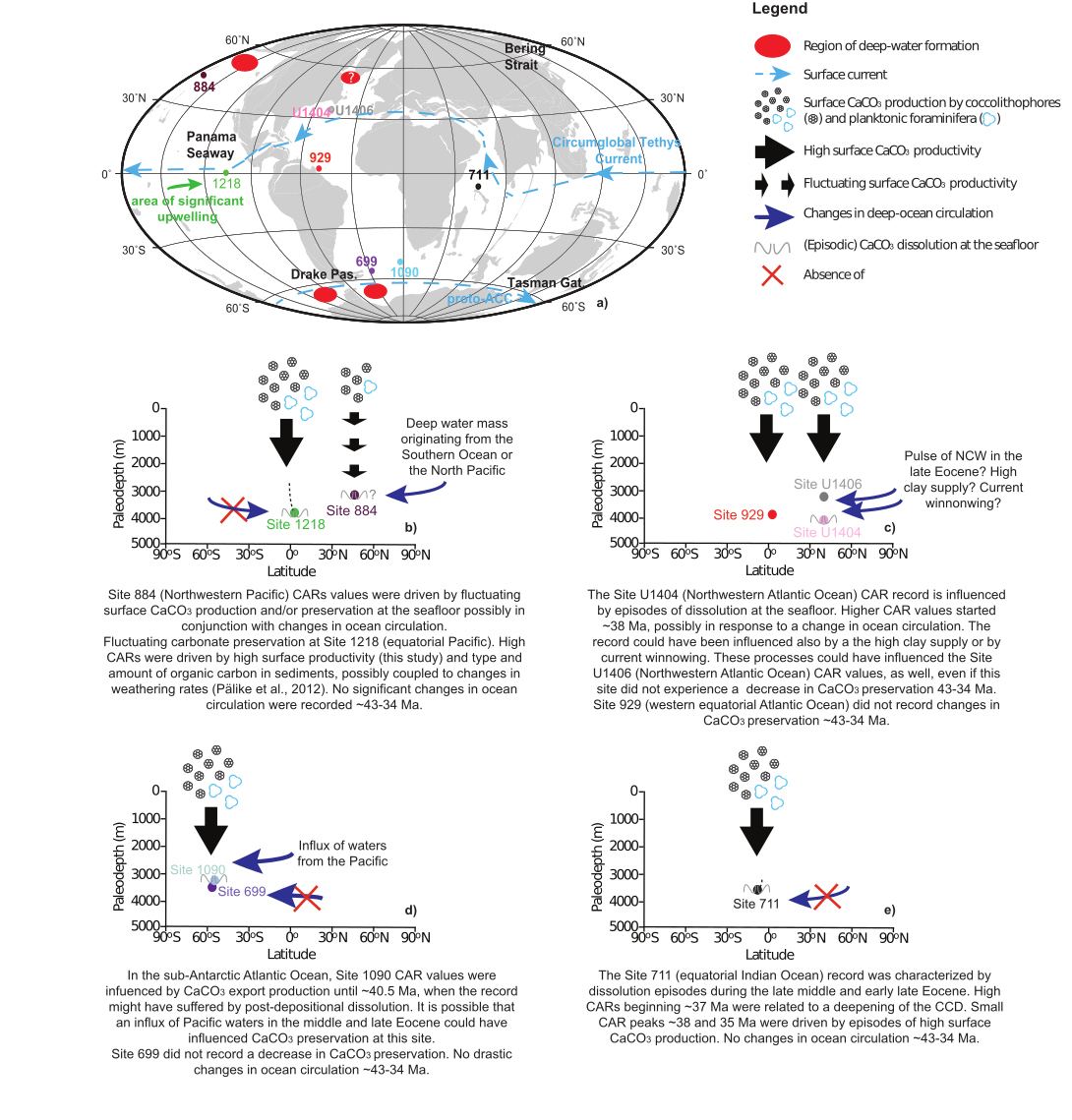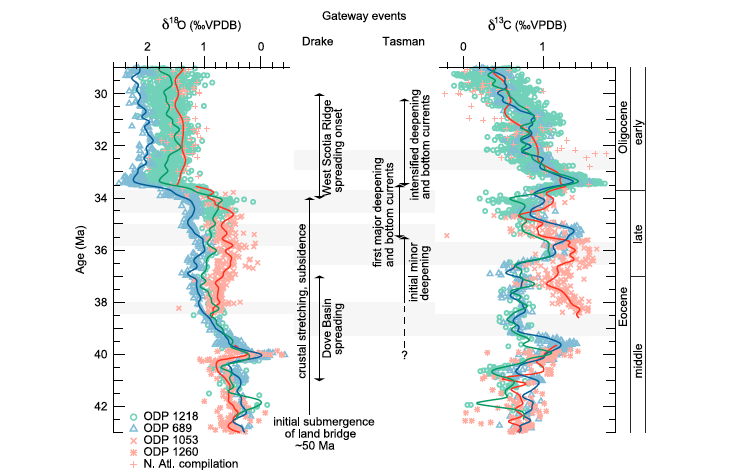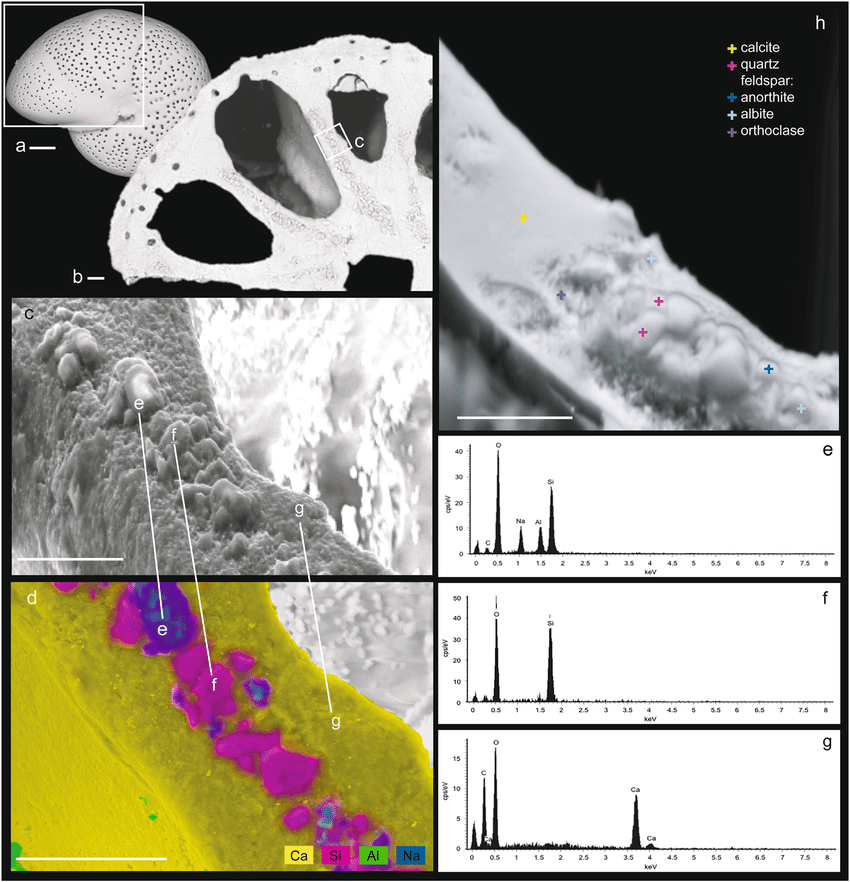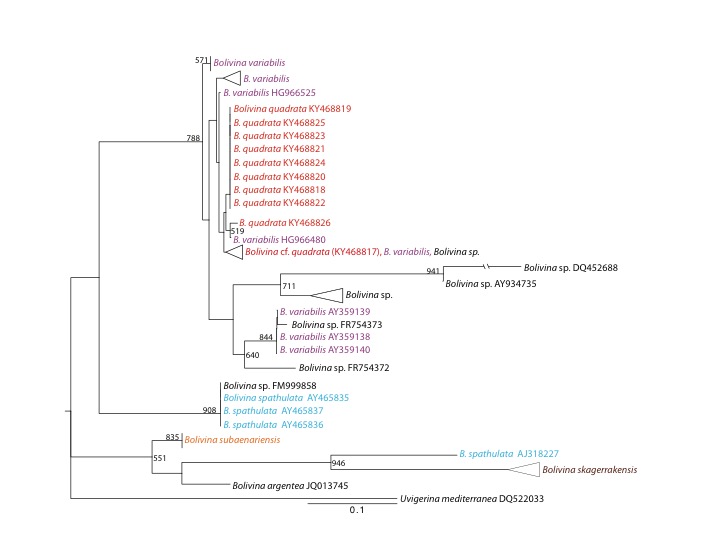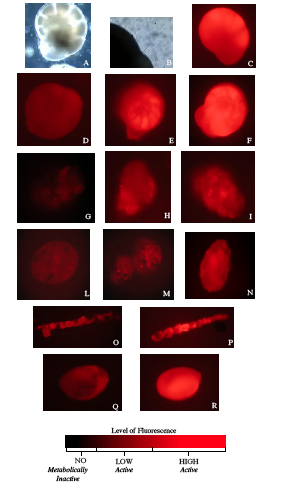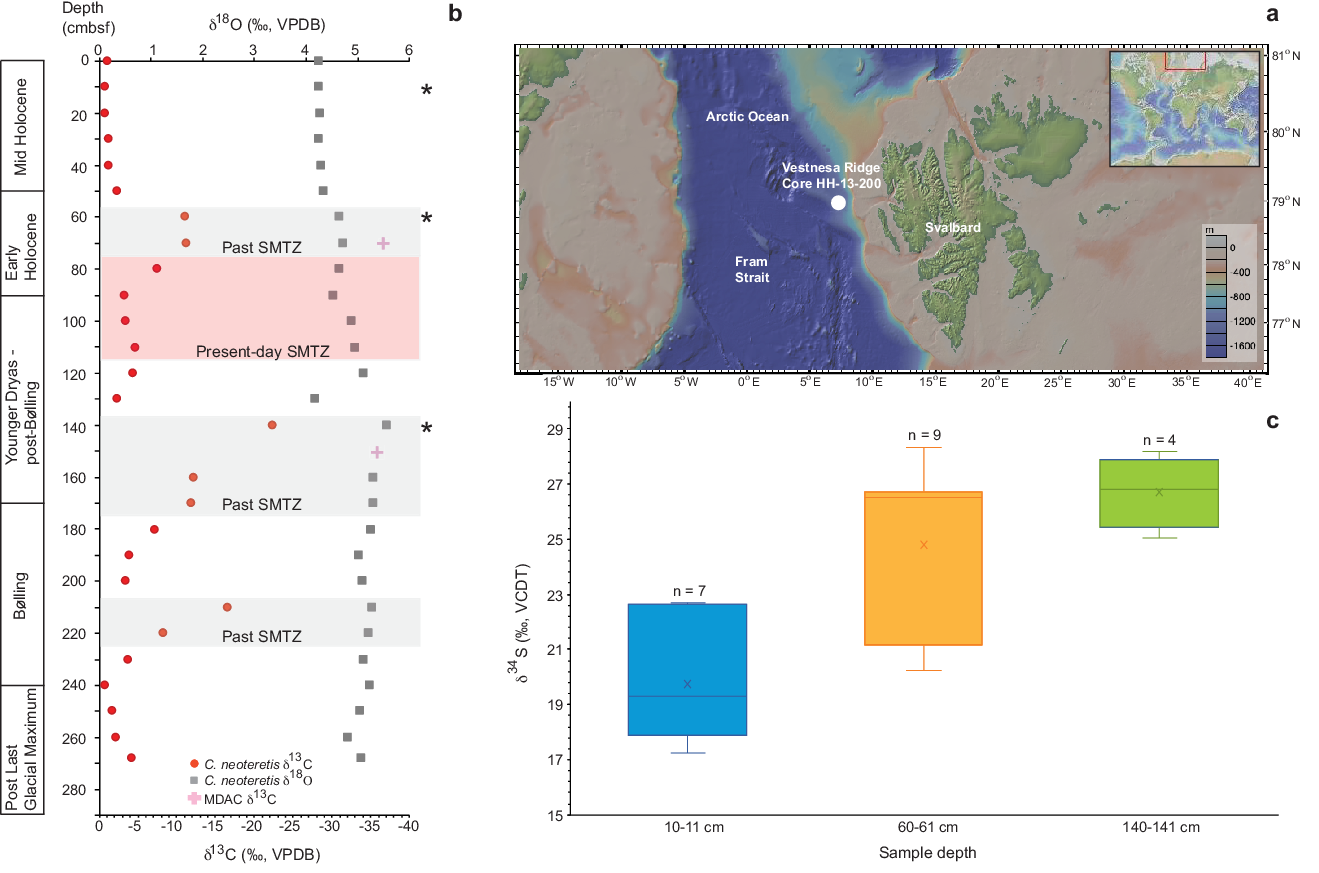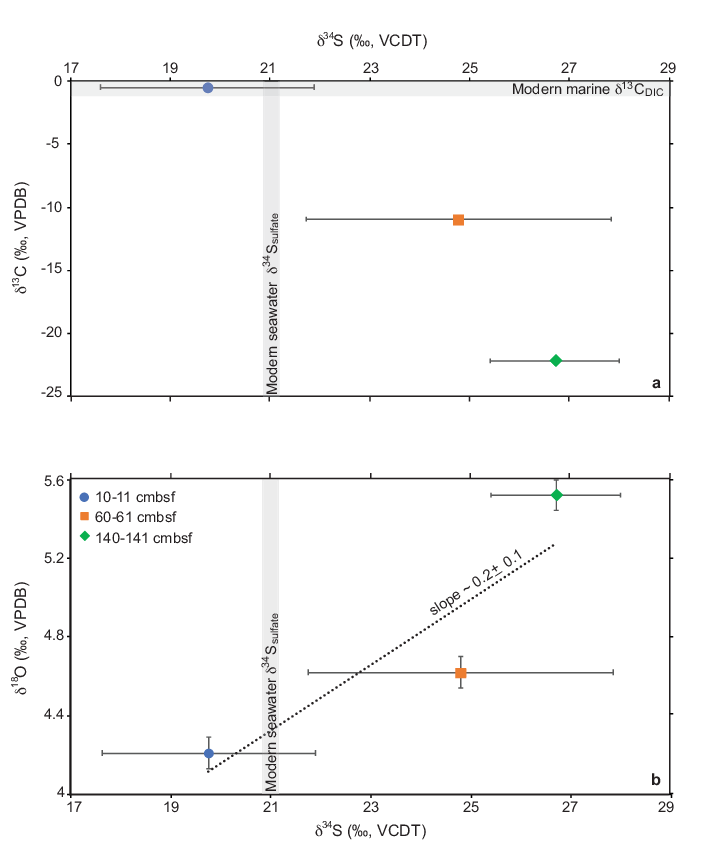- Middle to Late Eocene Changes of the Ocean Carbonate Cycle
Over geological time scales, the formation of calcium carbonate (CaCO3) at the surface of the ocean and its burial at the seafloor are important components of the global carbon cycle because of their impact on ocean alkalinity, dissolved inorganic carbon, and CO2 concentration in the atmosphere.
The middle and late Eocene (~43-34 Ma) is a particular interesting time because it marks the beginning of the Cenozoic greenhouse-to-icehouse climate transition, when Earth started to experience cooler temperature and the presence of permanent ice-sheets in Antarctica. Previous studies showed that CaCO3 burial at the seafloor was variable during this time, at least in the equatorial Pacific. However, data from other basins were sparse. In Borrelli et al. (2021), we investigate Eocene CaCO3 accumulation rates at several sites located at different paleodepths in the Pacific, Atlantic, Indian and Southern Oceans. Our data show that CaCO3 accumulation was highly heterogeneous in different ocean basins and at different paleodepths, emphasizing the importance of processes such as surface CaCO3 production, as well as ocean ventilation, in driving middle and late Eocene carbonate accumulation rates - Reconstructing past ocean circulation using benthic foraminifera: traditional approaches
Benthic foraminiferal stable isotopes (δ18Obf and δ13Cbf) represent an important tool to investigate changes in ocean circulation through time. For my Ph.D., I used δ18Obf and δ13Cbf to reconstruct oceanographic changes in the North Atlantic and in the North Pacific from the middle Eocene to the early Oligocene (~49-33 Ma). The late middle Eocene-early Oligocene (~40-33 Ma) represents one of the most important climatic transitions of the last 50 Mrys (the greenhouse-icehouse transition) because permanent large ice sheets started to appear in Antarctica and temperature started to cool.In Borrelli et al. (2014), my colleague and I provide evidence that the opening of the Drake Passage (which isolated Antarctica from South America ~41 Ma) and the Tasman Rise (which isolated Antarctica from Australia beginning prior to ~35.5 Ma) impacted ocean circulation in the Atlantic. In particular, this study shows that a modern-like ocean circulation began in the late middle Eocene (~38.5 Ma), with the development of a bipolar ocean circulation characterized by thermal differentiation between the deepwater mass originating in the Southern Ocean (Southern Component Water – SCW) and the deepwater mass originating in the North Atlantic (Northern Component Water – NCW).
In Borrelli and Katz (2015), we focus on ocean circulation in the northwestern Pacific. In this case, the collected data add significant structure to a lower-resolution record from the same location and suggest that the northwestern Pacific was bathed by: 1) a deepwater mass probably originating from the Southern Ocean (~49-43 Ma); 2) a regional warm deepwater mass possibly originating from surface waters downwelling at the higher latitudes of the North Pacific or warm saline deep waters originating at low latitudes (~42-37 Ma); and 3) a deepwater mass originating from the Southern Ocean and bathing other deep Pacific locations (~36.5-34 Ma).
- Novel biomineralization strategy in calcareous foraminifera
I have always been interested in understanding biomineralization processes in foraminifera. Considering that foraminifera are single-cell organisms, I find fascinating that we know so little about how these organisms precipitate their beautiful shells. In Borrelli et al. (2018b), my colleagues and I show that calcareous benthic foraminifera are capable of agglutinating sedimentary particles also. In particular, we focus on Melonis barleeanus. Traditionally considered a calcareous species, our data reveal the presence of minute (~3 μm) sedimentary particles (silicate grains) inside the chamber walls of the examined shells. These particles are arranged in a definitive and systematic pattern, and the similar grain chemical characterization and size suggest a relatively high degree of selectivity in both modern and fossil specimens. Based on these results, we propose that M. barleeanus is capable of agglutinating sedimentary particles during the formation of a new chamber. Considering that the isotopic and chemical composition of this species is widely used in paleoclimatic and paleoceanographic reconstructions, we used a mixing model to investigate the influence of sedimentary particles on M. barleeanus δ18O data. Our model show that the calcite δ18O would increase by ~0.9-2‰ if 10 wt% of feldspars (i.e., anorthite, albite, orthoclase) and quartz, respectively, were included in the analyzed shell. Overall, our results emphasize that it is of paramount importance to consider M. barleeanus unusual biomineralization strategy during the interpretation of geological records and to investigate the presence of similar processes in other calcareous foraminiferal species. - Assessing SSU rDNA Barcodes in Bolivinacea (Foraminifera)
The SSU rDNA (small subunit ribosomal DNA) is a widely used tool to reconstruct phylogenetic relationships among foraminiferal species. In Borrelli et al. (Borrelli et al. 2018a), my colleagues and I evaluate several SSU rDNA hypervariable regions (i.e., 37/f, 41/f, 43/e, and 45/e) as possible DNA barcodes to distinguish among species of the rotaliid genus Bolivina. The study shows that not all the Bolivina species are fully resolved when a single SSU rDNA hypervariable region is used as barcode and that some regions are better than others to distinguish among closely related species. In addition, intraspecific polymorphism analyses reveal a high degree of variability. In the context of barcoding studies, our results emphasize the need to assess the range of intraspecific variability of DNA barcodes prior their application to the identification of foraminiferal species in environmental samples, but they also stress the possibility that a longer SSU rDNA region might be necessary to distinguish among species belonging to the same taxonomic group (i.e., genus). - Benthic foraminiferal experimental ecology
Because of my background in marine biology, I am very interested in exploring the ecology of benthic foraminifera. In Borrelli et al. (2011), my colleagues and I explore the possibility to apply the fluorescent in situ hybridization (FISH) technique to identify living foraminiferal cells with an active metabolism using fluorescent probes targeting the SSU rRNA (small subunit ribosomal RNA). In particular, this study targets the most represented benthic species in coastal marine sediments, like the Ammonia group and Miliolids, as well as agglutinated polythalamous (i.e., Leptohalysis scottii and Eggerella scabra) and soft-shelled monothalamous (i.e., Psammophaga sp. and saccamminid morphotypes) taxa extracted from experimental settings and/or from natural samples. Our data indicate that FISH targets only metabolically active foraminifera and that it allows differentiating low vs. high cellular activity based on the intensity of the fluorescent signal emitted by the probe. These results demonstrate the usefulness of the FISH approach as a key tool to investigate the physiology of living foraminifera, in the field as well as in experimental settings. - The benthic foraminiferal δ34S records flux and timing of paleo methane emissions
Marine sediments are an important methane reservoir, in particular because of the presence of gas hydrates, solid structures of gas and water. Gas hydrates are stable under certain conditions of temperature and pressure and changes of these conditions can trigger hydrate dissociation with the consequent release of methane. Considering the current increase in sea surface temperature, there is some concern regarding the stability of the gas hydrate reservoir and the potential impact of gas hydrate dissociation on climate. One way to tackle this issue is through the investigation of geological records. In fact, dissociation of gas hydrates and the transfer of marine methane to the active oceanic carbon system has been hypothesized as the cause, and/or a feedback, of rapid global warming episodes in the geological past.In Borrelli et al. (2020), my colleagues and I demonstrate the possibility of using the benthic foraminiferal sulfur isotopic signature (δ34S) as a novel approach to reconstruct the flux (i.e., diffusive vs. advective) and timing of methane emissions in fossil records. Specifically, we analyzed the δ34S of Cassidulina neoteretis specimens of several samples from Vestnesa Ridge, a site of known gas hydrates and methane seepage in the Arctic Ocean. The data collected show that the benthic foraminiferal δ34S values are lower in the sample characterized by seawater conditions compared to the samples influenced by the presence of past sulphate-methane transition zones (δ34S values of ∼20‰ vs. ∼25–27‰), as supported by bulk benthic foraminiferal δ13C data. Instead, the benthic foraminiferal δ18O – δ34S correlation provides a new tool to indirect date past methane emission. For example, it suggests that methane was advecting during the Early Holocene and the Younger-Dryas – post-Bølling at our sampling site.
